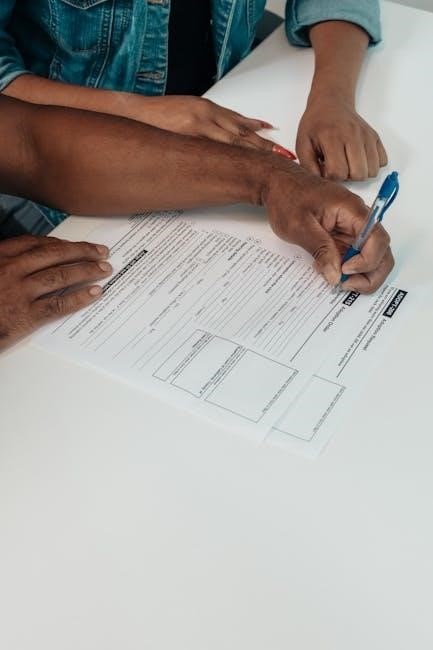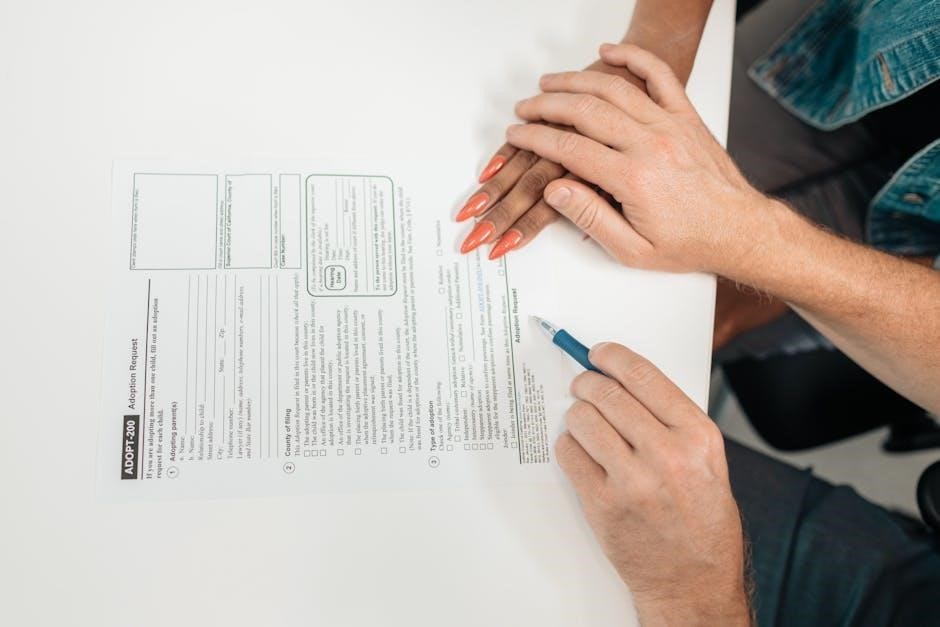The Application to Vary or Revoke AVO Form is a legal document used to modify or cancel an existing Apprehended Violence Order (AVO). Understanding its purpose and process is crucial for making informed changes to an AVO‚ ensuring the safety and rights of all parties involved are appropriately addressed.
1.1 What is an AVO?
An Apprehended Violence Order (AVO) is a court-issued order designed to protect a person (the protected person) from violence‚ harassment‚ intimidation‚ or other threatening behavior by another individual (the defendant). It is a legal contract outlining specific conditions the defendant must adhere to‚ ensuring the protected person’s safety. AVOs are categorized into Provisional‚ Interim‚ and Final orders‚ each serving distinct purposes and durations. Breaching an AVO can result in criminal charges‚ emphasizing its enforceability through the court system. Understanding the role and implications of an AVO is essential when considering applications to vary or revoke it‚ as it directly impacts the rights and obligations of both parties involved.
1.2 Why Vary or Revoke an AVO?
An AVO may be varied or revoked due to changed circumstances or mutual agreement between the parties. Common reasons include the protected person no longer fearing for their safety‚ significant changes in living situations‚ or the order causing undue hardship to the defendant. Revocation is sought when the AVO is no longer necessary or justifiable. The court considers whether the original reasons for the AVO still apply and if the safety and welfare of the protected person remain at risk. Legal advice is crucial to navigate this process effectively and ensure the application is based on valid grounds‚ as courts may refuse requests without substantial justification.

Understanding the Process
Obtaining and completing the application form is the first step to vary or revoke an AVO. The process involves filling in the form‚ serving it to the relevant parties‚ and attending court for the matter to be considered.
2.1 Obtaining the Application Form
To initiate the process of varying or revoking an AVO‚ you must obtain the correct Application to Vary or Revoke Apprehended Violence Order form. This form is not available online and must be collected from the court registry. Ensure you request the specific form applicable to your situation‚ such as the Application for Apprehended Domestic Violence Order or Application for Apprehended Personal Violence Order. Each form comes with a step-by-step guide to help you understand how and when to use it. If unsure‚ consulting an experienced AVO lawyer can provide clarity and assistance in drafting the application correctly. Properly completing and filing this form is essential for moving forward with your request.
2.2 Filling in the Application Form
Filling in the Application to Vary or Revoke Apprehended Violence Order form requires careful attention to detail. You must clearly outline the grounds for your application‚ such as a change in circumstances or mutual agreement. Provide specific details about why the AVO should be varied or revoked‚ ensuring your reasons align with legal requirements. Include any relevant evidence or supporting documents to strengthen your case. The form must be completed accurately‚ as errors may delay the process. If the protected person is a child‚ additional steps may apply. Once completed‚ the form must be filed with the court and served to the relevant parties‚ such as the protected person or police. Seeking legal advice is highly recommended to ensure compliance with all requirements. Properly completing the form is crucial for a successful application.
2.3 Serving the Application
Serving the Application to Vary or Revoke AVO is a critical step in the process. Once filed‚ the application must be properly served to the relevant parties. For police AVOs‚ a copy must be served to the Local Area Command of the police who applied for the order. For private AVOs‚ the application should be directly served to the protected person. If the protected person is a child‚ additional steps may be required‚ such as seeking court permission. The application must be served in accordance with legal requirements to ensure validity. Failure to serve the application correctly may result in the court refusing the request. Legal advice is recommended to ensure proper service and compliance with all procedural requirements. Timely and accurate service is essential for moving the application forward. Proper service ensures all parties are notified and can respond appropriately.

Grounds for Varying or Revoking an AVO
An AVO can be varied or revoked if there is a change of circumstances‚ mutual agreement‚ or if it causes undue hardship to the defendant without justification.
3.1 Change of Circumstances
A change of circumstances is a key ground for varying or revoking an AVO. This may include the protected person no longer fearing for their safety‚ significant changes in living arrangements‚ or the defendant’s behavior improving. Courts require evidence of such changes to justify modifying or cancelling the order. If circumstances have altered since the AVO was issued‚ either party can apply to the court to reassess the order’s necessity. The application must outline these changes clearly. A court may refuse the application if no substantial changes are demonstrated‚ ensuring the order remains only if it continues to serve its protective purpose. Legal advice is recommended to navigate this process effectively.
3.2 Mutual Agreement
A mutual agreement between the protected person and the defendant can serve as a valid reason to vary or revoke an AVO. Both parties may agree that the order is no longer necessary‚ particularly if their relationship has improved or if circumstances have changed. However‚ the court prioritizes the protected person’s safety and may require evidence of the agreement and the reasons behind it. The application must be filed with the court‚ and both parties may need to provide statements or attend a hearing. Legal representation is advisable to ensure the agreement is legally binding and the court’s concerns are addressed. The court will assess whether the agreement aligns with the protected person’s ongoing safety and well-being before approving any changes to the AVO.

Types of AVOs
There are three types of AVOs: Provisional‚ Interim‚ and Final. Each serves distinct purposes‚ providing varying levels of protection based on the situation and court decisions.
4.1 Provisional AVO
A Provisional AVO is issued by police in urgent situations without a court hearing‚ providing immediate protection. It remains in effect until a court reviews the case. This type of AVO is often served to the defendant and outlines temporary conditions to prevent harm or threats. A Provisional AVO can be varied or revoked if circumstances change or mutual agreement is reached. However‚ if the protected person is a child‚ specific legal requirements and permissions may apply. Courts prioritize safety and welfare when considering modifications to a Provisional AVO‚ ensuring the order remains appropriate and necessary.
4.2 Interim AVO
An Interim AVO is a temporary order issued by the court to provide immediate protection until a final decision is made. It is typically granted during the initial stages of an AVO application and remains in force until the court conducts a full hearing. An Interim AVO can be sought in urgent situations where there is an immediate risk of harm or harassment. This type of order can be varied or revoked if circumstances change or if both parties agree to modifications. The court will consider the safety and welfare of the protected person when deciding whether to alter or cancel an Interim AVO. Proper legal procedures‚ including serving the application‚ must be followed to ensure the process is valid and enforceable.
4.3 Final AVO
A Final AVO is a long-term order issued after a full court hearing‚ where both parties have the opportunity to present evidence. It outlines specific conditions that the defendant must adhere to in order to protect the protected person from harm‚ harassment‚ or intimidation. A Final AVO can be varied or revoked if there are significant changes in circumstances‚ such as the protected person no longer fearing for their safety or mutual agreement between the parties. The court will carefully consider the safety and welfare of the protected person before making any changes. The process to modify or cancel a Final AVO involves filing an application with the court and serving it to the relevant parties‚ ensuring all legal requirements are met to justify the requested changes.

Legal Requirements
The Application to Vary or Revoke AVO Form requires specific legal documents‚ such as a Notice of Motion Affidavit‚ to be filed with the court. Proper service of the application to the protected person or police (for police AVOs) is mandatory. Legal advice is strongly recommended to ensure compliance with all requirements and to draft the necessary forms accurately. The court may refuse the application if procedures are not followed correctly‚ emphasizing the importance of adhering to legal standards throughout the process.
5.1 Necessary Forms
To apply to vary or revoke an AVO‚ specific forms must be completed and filed with the court. The primary form required is the Application to Vary or Revoke Apprehended Violence Order‚ which outlines the reasons for the request; Additionally‚ a Notice of Motion Affidavit may be necessary to provide detailed evidence supporting the application. These forms are not available online and must be obtained from the court registry. Proper completion and submission of these documents are critical‚ as errors or omissions can delay or dismiss the application. Legal advice is recommended to ensure all forms are correctly prepared and filed‚ especially for complex cases or indefinite AVOs.
5.2 Role of the Court
The court plays a central role in determining applications to vary or revoke an AVO. It reviews the submitted forms‚ evidence‚ and circumstances to decide whether changes are warranted. The court’s primary consideration is the safety and welfare of the protected person‚ ensuring their protection while balancing the rights of the defendant. For indefinite AVOs‚ the court requires a compelling reason to revoke or vary the order. The court may also request additional evidence or hold hearings to assess the merits of the application. Legal representation is highly recommended‚ as the court’s decision-making process can be complex and requires adherence to specific legal standards and procedures.
5.3 Evidence Required
Evidence is crucial when applying to vary or revoke an AVO. The court requires detailed documentation to assess the merits of the application. This includes affidavits‚ witness statements‚ and any relevant documentation‚ such as proof of changed circumstances or mutual agreements. The evidence must clearly demonstrate why the AVO should be modified or canceled. For example‚ if the protected person no longer fears for their safety‚ they must provide evidence to support this claim. Similarly‚ if the AVO causes undue hardship to the defendant‚ evidence of this impact must be submitted. The court carefully evaluates the evidence to ensure the decision aligns with the safety and welfare of all parties involved. Properly prepared evidence is essential for a successful application.

Filing and Serving the Application
Filing the application involves submitting the completed form to the appropriate court registry. Serving the application ensures all parties‚ including the protected person and police‚ receive notice. Proper service is essential to avoid delays and ensure the court can proceed with the matter. The application must be served correctly‚ as failure to do so may result in the court refusing the request. The process varies depending on whether it’s a police or private AVO‚ with specific requirements for each. Ensuring timely and accurate service is crucial for the application to be considered.
6.1 How to File the Application
To file the application to vary or revoke an AVO‚ obtain the correct form from the court registry or a legal professional. Ensure the form is completed accurately‚ detailing the grounds for the request. Attach any supporting evidence‚ such as affidavits or documents proving changed circumstances. Submit the application to the appropriate court registry‚ either in person or via mail‚ depending on the court’s requirements. The court will review the application and may list it for a hearing. If the application is urgent‚ request an expedited hearing. Filing fees may apply‚ and legal advice is recommended to ensure compliance with procedural requirements. The court will notify all parties of the hearing date‚ typically within a month of filing.
6.2 Serving the Application Correctly
Serving the application to vary or revoke an AVO correctly is a critical step to ensure the process is valid. For police AVOs‚ the application must be served to the Local Area Command (LAC) of the police who applied for the order. For private AVOs‚ the application should be directly served to the protected person (PINOP). If the PINOP is a child‚ additional steps may be required‚ such as seeking court permission. The application must be served in person or via registered mail‚ with proof of service obtained. Failure to serve the application correctly may result in the court refusing the request. Legal advice is recommended to ensure compliance with serving requirements and to avoid delays or dismissal of the application.

Court Proceedings
Court proceedings for varying or revoking an AVO involve a hearing where both parties present evidence. The court considers the safety and welfare of the protected person.
7.1 The Hearing Process
The hearing process for varying or revoking an AVO involves both parties presenting evidence to the court. A listing date is typically set within a month of filing the application. During the hearing‚ the protected person‚ defendant‚ and any witnesses may provide oral evidence. The court considers whether the changes are necessary for the safety and welfare of the protected person. If the application is contested‚ the court may order both parties to submit written statements. The court’s decision is based on the evidence presented and the circumstances of the case. Legal representation is highly recommended to navigate the complexities of the hearing process effectively.
7.2 Possible Outcomes
The court may grant‚ vary‚ or dismiss the application to vary or revoke an AVO. If granted‚ the AVO can be revoked‚ modified‚ or extended. The court may also impose new conditions or remove existing ones. If the application is dismissed‚ the AVO remains in force as originally ordered. In some cases‚ the court may extend the AVO if it deems it necessary for the protected person’s safety. The outcome depends on the evidence presented and the court’s assessment of the circumstances. If the AVO is revoked‚ it no longer applies‚ and the defendant is no longer bound by its conditions. The court’s decision is final unless appealed‚ and legal advice is recommended to understand the implications of the outcome.

Costs and Legal Representation
Costs for varying or revoking an AVO vary based on case complexity and whether the application is contested. Legal representation is highly recommended due to the intricate process.
8.1 Costs Involved
The costs to vary or revoke an AVO can vary significantly depending on the complexity of the case and whether the application is contested. Legal fees for drafting and filing the application‚ serving the documents‚ and court representation can accumulate. If the matter goes to a hearing‚ additional costs may arise for preparing evidence and attending court. In some cases‚ the court may order one party to pay the other’s legal costs if the application is unsuccessful. It is important to consult with a lawyer to understand the potential costs involved and how they may apply to your specific situation. Legal advice can help navigate the process efficiently and minimize unnecessary expenses.
8.2 Importance of Legal Advice
Seeking legal advice is crucial when applying to vary or revoke an AVO. The process involves complex legal requirements‚ and incorrect or incomplete applications can lead to dismissal. A lawyer can guide you through the process‚ ensuring all necessary forms and evidence are properly prepared. They can also represent you in court‚ advocating for your interests and helping you navigate the legal system. Additionally‚ legal advice can help you understand the potential consequences of your application and ensure you comply with all court procedures. Given the serious implications of an AVO‚ professional legal guidance is essential to achieve the best possible outcome for your specific situation.

Specific Scenarios
Specific scenarios‚ such as when the protected person is a child or dealing with indefinite AVOs‚ require careful consideration. Legal complexities and unique circumstances demand tailored approaches to ensure fairness and protection for all parties involved.
9.1 When the Protected Person is a Child
When the protected person is a child (under 16)‚ specific legal requirements apply. The court must grant leave for any variation or revocation of the AVO. Section 72B of the Crimes (Domestic and Personal Violence) Act 2007 requires the court to consider the child’s best interests. The defendant cannot apply to vary a provisional AVO if the protected person is a child. Instead‚ the application must first be made interim before any changes can be sought. The court will notify the Commissioner of Police and the Department of Family and Community Services before varying or revoking the order. This ensures the child’s safety and welfare remain paramount throughout the process.
9.2 Indefinite AVOs
An Indefinite AVO remains in effect indefinitely‚ providing ongoing protection to the protected person. Under Section 79B of the Crimes (Domestic and Personal Violence) Act 2007‚ such orders are made when the court deems it necessary for the protected person’s safety. To revoke or vary an indefinite AVO‚ the defendant must seek the court’s permission. The protected person will be notified of the application‚ and if they object‚ they can submit a written statement. The court will assess whether the order is still required for the protected person’s protection. Legal advice is strongly recommended‚ as the process is complex and requires meeting specific legal thresholds to succeed; The court’s decision will prioritize the protected person’s safety and well-being.

Consequences of an AVO
An AVO imposes restrictions on the defendant‚ such as limiting contact with the protected person. It can also impact employment‚ particularly in industries requiring firearms licenses or security clearances.
10.1 Restrictions on the Defendant
An AVO imposes specific restrictions on the defendant‚ such as prohibiting contact or proximity to the protected person. These restrictions aim to ensure the protected person’s safety and well-being. The defendant may be barred from residing in the same household‚ attending certain locations‚ or possessing firearms. Breaching an AVO can result in criminal charges‚ fines‚ or imprisonment. Additionally‚ an AVO can impact the defendant’s employment‚ particularly in industries requiring firearms licenses or security clearances. The restrictions remain in effect until the AVO is revoked or modified by the court. Understanding these limitations is crucial for compliance and avoiding legal consequences.
10.2 Impact on Employment and Licensing
An AVO can significantly impact the defendant’s employment and licensing opportunities. For instance‚ individuals subject to an AVO may be prohibited from holding a firearms licence for up to 10 years‚ affecting careers in security‚ law enforcement‚ or hunting; Certain professions‚ such as those requiring a working-with-children check or high-security clearances‚ may also be restricted. Employers may view an AVO as a liability‚ potentially leading to job loss or difficulties in securing new employment. Additionally‚ the stigma associated with an AVO can harm professional reputations. These consequences underscore the importance of carefully considering the long-term effects of an AVO when deciding whether to apply for variations or revocations.
In conclusion‚ the process to vary or revoke an AVO involves complex legal steps‚ emphasizing the importance of court procedures and the need for professional legal guidance to navigate effectively.
11.1 Summary of Key Points
The process to vary or revoke an AVO involves obtaining the correct application form‚ outlining grounds for change‚ and serving the application to all relevant parties. Courts require evidence to support requests‚ and outcomes depend on whether the changes are deemed necessary and fair. Legal representation is highly recommended due to the complexity of the process. Understanding the legal requirements‚ such as necessary forms and court procedures‚ is essential for a successful application. The court prioritizes the safety and well-being of the protected person while balancing the rights of the defendant. Professional legal advice ensures compliance with the law and increases the likelihood of a favorable outcome.
11.2 Importance of Legal Advice
Seeking legal advice is crucial when applying to vary or revoke an AVO. The process is complex‚ and legal requirements are stringent‚ making professional guidance essential. A lawyer can help navigate the intricate legal system‚ ensuring the application is properly drafted and filed. They can also assist in gathering necessary evidence and representing you in court. Without proper legal advice‚ applications may be dismissed due to procedural errors. Legal experts can provide tailored strategies based on your specific circumstances‚ increasing the likelihood of a successful outcome. Additionally‚ they can address unique scenarios‚ such as indefinite AVOs or cases involving children‚ ensuring your rights and interests are protected throughout the process.
